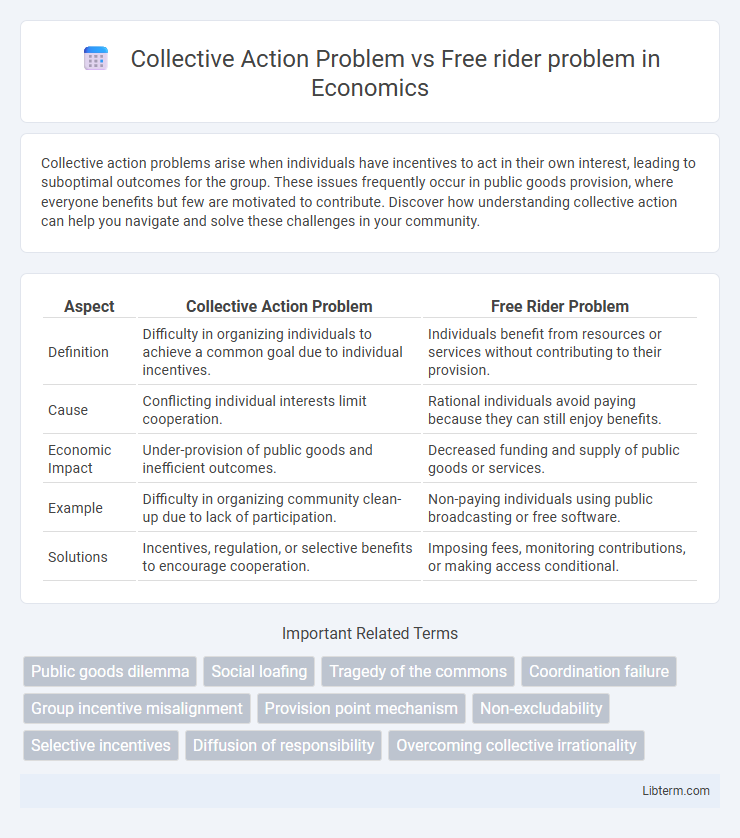Collective action problems arise when individuals have incentives to act in their own interest, leading to suboptimal outcomes for the group. These issues frequently occur in public goods provision, where everyone benefits but few are motivated to contribute. Discover how understanding collective action can help you navigate and solve these challenges in your community.
Table of Comparison
| Aspect | Collective Action Problem | Free Rider Problem |
|---|---|---|
| Definition | Difficulty in organizing individuals to achieve a common goal due to individual incentives. | Individuals benefit from resources or services without contributing to their provision. |
| Cause | Conflicting individual interests limit cooperation. | Rational individuals avoid paying because they can still enjoy benefits. |
| Economic Impact | Under-provision of public goods and inefficient outcomes. | Decreased funding and supply of public goods or services. |
| Example | Difficulty in organizing community clean-up due to lack of participation. | Non-paying individuals using public broadcasting or free software. |
| Solutions | Incentives, regulation, or selective benefits to encourage cooperation. | Imposing fees, monitoring contributions, or making access conditional. |
Understanding the Collective Action Problem
The Collective Action Problem occurs when individuals in a group face challenges coordinating to achieve a common goal, often due to conflicting individual interests. This problem highlights difficulties in mobilizing cooperation because the benefits of collective success are shared regardless of individual contribution. Understanding this concept is essential for addressing issues like public goods provision and managing social dilemmas effectively.
Defining the Free Rider Problem
The Free Rider Problem occurs when individuals benefit from resources, goods, or services without paying for them, leading to under-provision or depletion of those resources. It is a specific case within the broader Collective Action Problem, where individuals have incentives to avoid contributing while still enjoying collective benefits. This problem often hinders effective cooperation in public goods provision and common-pool resource management.
Key Differences Between Collective Action and Free Rider Problems
The collective action problem arises when individuals face difficulties coordinating efforts to achieve a common goal, whereas the free rider problem occurs when individuals benefit from resources without contributing to their provision. In collective action dilemmas, high coordination costs and diverse interests hinder group success; free rider issues specifically relate to the exploitation of public goods due to non-excludability. Understanding these distinctions is crucial for designing effective policies that promote cooperation and equitable resource sharing.
Historical Background and Theoretical Foundations
The Collective Action Problem, extensively analyzed by Mancur Olson in his 1965 work "The Logic of Collective Action," highlights the difficulties groups face in achieving common interests when individual incentives to participate are weak. The Free Rider Problem, a specific manifestation within this framework, arises when individuals benefit from resources, goods, or services without contributing to their provision or maintenance, undermining collective efforts. Both concepts draw from economic theory and political science, emphasizing the tension between individual rationality and group welfare in public goods provision and social cooperation.
Real-World Examples of Collective Action Problems
Collective action problems arise when individuals face incentives to withhold effort, leading to suboptimal outcomes, such as climate change mitigation where countries hesitate to reduce emissions despite global benefits. Free rider problems occur when individuals benefit from resources or services without contributing, exemplified by public goods like clean air or national defense. Real-world cases include vaccination campaigns and public broadcasting funding, where collective participation is essential but individual incentives to abstain challenge success.
Free Rider Problem in Public Goods Provision
The Free Rider Problem occurs when individuals benefit from public goods without contributing to their provision, leading to underfunding and potential failure of collective projects. Unlike the broader Collective Action Problem, the Free Rider issue specifically highlights the challenge of non-excludability and non-rivalry in public goods, where voluntary contributions decline as people rely on others to bear the cost. Effective mechanisms like taxation or regulatory frameworks are necessary to mitigate free riding and ensure sustainable public goods provision.
Causes and Consequences of Free Riding
Free riding occurs when individuals benefit from resources, goods, or services without paying for their cost, driven by rational self-interest and the difficulty of excluding non-payers from public goods. This behavior undermines collective action by reducing the available resources needed to sustain the good or service, leading to inefficiencies and potential collapse of cooperative efforts. The consequences include diminished public goods provision, increased burden on contributors, and the potential failure of collective projects or policies due to insufficient participation and funding.
Solutions and Strategies for Collective Action Challenges
Effective solutions to the Collective Action Problem emphasize incentivizing participation through mechanisms like selective incentives, social norms, and institutional enforcement to mitigate free rider behavior. Strategies include designing contribution schemes that align individual interests with group benefits, employing monitoring and sanctioning systems, and fostering trust and cooperation via communication and repeated interactions. Implementing decentralized governance and leveraging technology for transparency further enhance collective action by reducing barriers to coordination and accountability.
Policy Implications and Institutional Approaches
Addressing the Collective Action Problem and Free Rider Problem requires policy interventions that enhance cooperation and incentivize contributions to public goods. Institutional approaches such as establishing clear property rights, implementing monitoring and sanction mechanisms, and promoting transparent decision-making increase accountability and reduce free-riding behaviors. Effective policies often combine regulatory frameworks with community-based governance to align individual incentives with collective outcomes.
Future Directions in Addressing Collective Action and Free Riding
Future directions in addressing the collective action problem and free rider problem focus on leveraging advanced technology such as blockchain for transparent and verifiable contribution tracking, enhancing incentive structures through behavioral economics insights, and implementing decentralized governance models to increase participation and accountability. Research emphasizes the integration of AI-driven monitoring systems to detect and mitigate free riding behaviors while promoting cooperative strategies in public goods provision. Emerging interdisciplinary approaches combine social network analysis with machine learning to design adaptive mechanisms that dynamically optimize collective efforts and resource allocation.
Collective Action Problem Infographic

 libterm.com
libterm.com